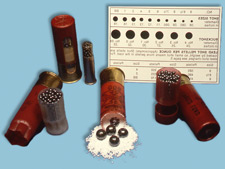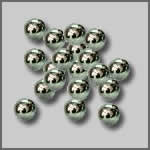Home | Glossary | Resources | Help | Contact Us | Course Map
Archival Notice
This is an archive page that is no longer being updated. It may contain outdated information and links may no longer function as originally intended.
Current Manufacture
The current technique for manufacturing shot pellets is accomplished with the Bliemeister method. This method eliminates the need for a shot tower.
The steps to produce round pellets are:
- Molten lead passes through successive screens that are repeatedly agitated.
- Lead droplets fall less than one inch into hot water (as opposed to a ten-story drop).
- The near-spherical pellets roll down an incline and are sorted by shape.
- The nonrounded, rejected shapes are recycled and remelted.
In the United States, large shot pellets (buckshot) range in size from .24 caliber (No. 4 Buck) to .36 caliber (000 Buck). Buckshot was once formed as drop shot, but large drops of lead do not form into spheres as readily as small drops and the rejection rate was high.
Today, most buckshot is made from lead wire using the following process:
- A strand of wire is fed between two counter-rotating wheels that meet rim-to-rim.
- Hemispheres are milled into the rim of each wheel.
- Rotation is timed so that the hemispheres in each wheel meet as the wheels turn.
- Round balls are formed where the cavities meet and excess lead is flattened.
- After rolling, the flattened strip is tumbled to remove the excess lead and free the pellets. The tumbling action also improves concentricity of the pellets.
Lead pellets may be plated with copper or nickel before loading. A tough outer coating helps protect the pellets from deformation. This step is reserved for premium-grade ammunition.
Lead-Free Shot Pellets
Concern over the potential effects of the ingestion of lead shot by waterfowl led to the adoption of lead-free shot for hunting. Soft steel was the first substitute pellet material. Pellets start as molten mild steel that is ejected at high speed and pressure into a water spray booth. The steel hardens into spheres and ovoids; the same shape-sorting process used for lead shot separates the best pellets for waterfowl ammunition. As field experience with the new pellets increased, it became obvious to hunters that the lighter, faster steel pellets were much different in performance than lead pellets. The transition to the use of steel shot also required the development of special wads to prevent damage to gun barrels.
Tungsten, nickel, bismuth, and mixtures of these have increased pellet density closer to that of lead. Due to competition, most manufacturers do not release details of how they make their nontoxic products. Some of the two-component nontoxic pellets are sintered. Powdered metals in the correct proportion are pressed and heated in molds, fusing them into solid pellets.
Jacketed Bullets
Bullets with metal jackets largely replaced plain lead bullets at about the same time that smokeless propellants replaced black powder in the majority of rifle ammunition. The higher pressures and temperatures produced by smokeless propellants were more than plain lead could support. This was overcome by adding an outer skin of harder metal to lead bullets.
Since pure copper is difficult to cold-work, copper alloys became the standard jacket material. Two copper alloys are prevalent in modern jackets, gilding metal (copper:zinc ratio of 95:5) and commercial bronze (copper:zinc ratio of 90:10). The choice of alloy depends on jacket thickness and the amount of work required to reach that thickness. The stronger bronze alloy is common in thin jackets, which are used to make handgun bullets.
In some parts of the world, soft steel is the more common jacket material. Steel is inexpensive, but more difficult to work. Nearly all steel jackets are treated with a rust preventative to ensure dimensional stability over time. This is typically accomplished with the application of transparent lacquers or by flash plating the steel with copper.
Additional Online Courses
- What Every First Responding Officer Should Know About DNA Evidence
- Collecting DNA Evidence at Property Crime Scenes
- DNA – A Prosecutor’s Practice Notebook
- Crime Scene and DNA Basics
- Laboratory Safety Programs
- DNA Amplification
- Population Genetics and Statistics
- Non-STR DNA Markers: SNPs, Y-STRs, LCN and mtDNA
- Firearms Examiner Training
- Forensic DNA Education for Law Enforcement Decisionmakers
- What Every Investigator and Evidence Technician Should Know About DNA Evidence
- Principles of Forensic DNA for Officers of the Court
- Law 101: Legal Guide for the Forensic Expert
- Laboratory Orientation and Testing of Body Fluids and Tissues
- DNA Extraction and Quantitation
- STR Data Analysis and Interpretation
- Communication Skills, Report Writing, and Courtroom Testimony
- Español for Law Enforcement
- Amplified DNA Product Separation for Forensic Analysts




